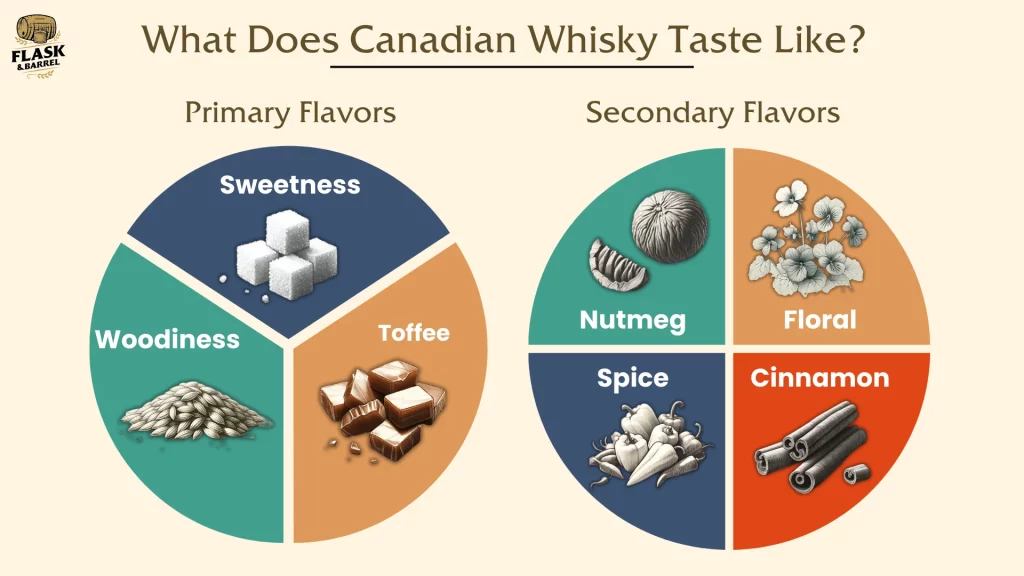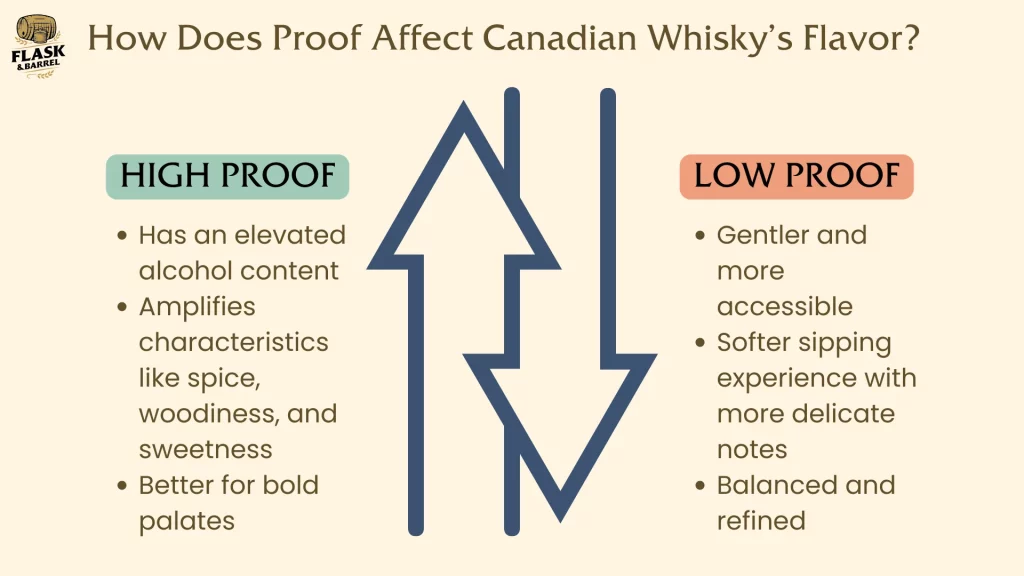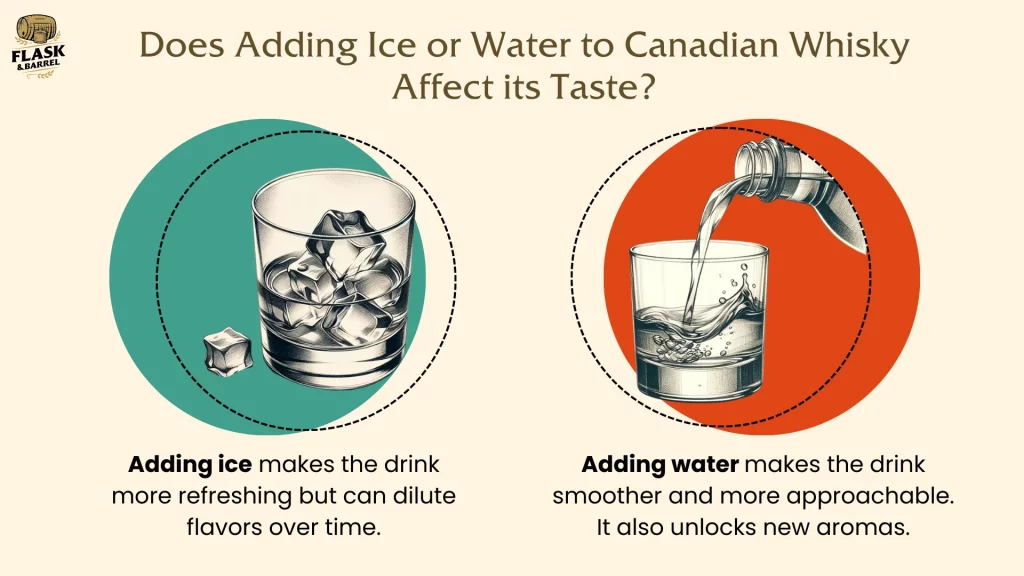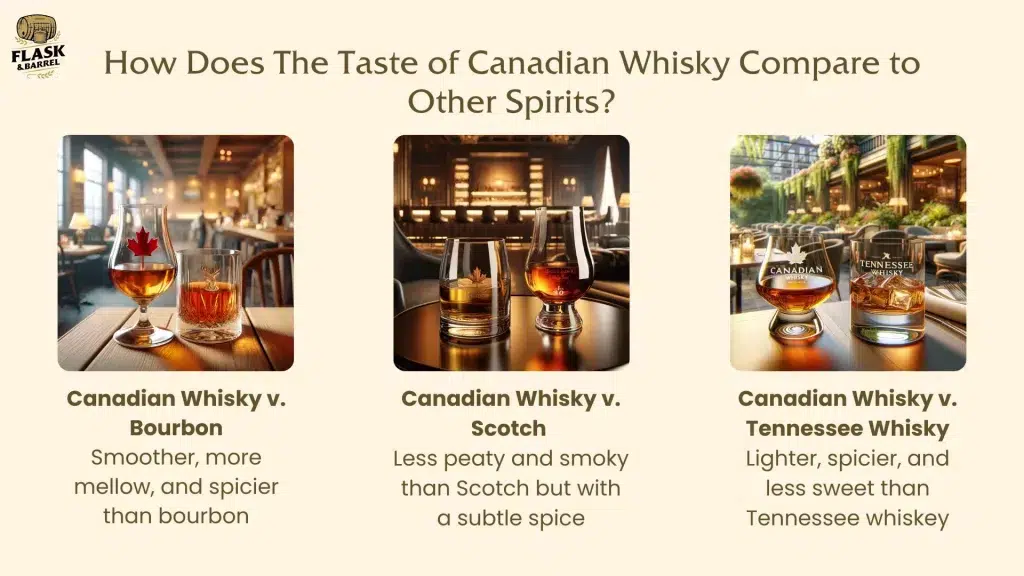Canadian whisky, often overshadowed by its more renowned Scottish and American counterparts, carves out its niche with an unparalleled smoothness and a complex yet approachable flavor profile. This distinctive character sets it apart in the expansive whisky world, marking Canadian whisky as a unique category unto itself. Key varieties within this category include Rye Whisky, often considered the classic Canadian style, along with Corn Whisky and Blended Whiskies, each known for their distinct tastes.
What Does Canadian Whisky Taste Like?
Single Grain Canadian whisky also emerges as a notable mention, offering a lighter but intricately flavored option for whisky aficionados. Delving deeper, each type of Canadian whisky brings its own array of flavors, production methodologies, historical backgrounds, and pairing suggestions with food. The subsequent sections will delve into these facets in detail, providing a deeper understanding of what makes Canadian whisky a prized spirit across the globe.

Canadian whisky is celebrated for its smoothness and a harmonious balance of flavors, making it a distinct and versatile spirit in the whisky world. At the heart of its flavor profile are primary flavors like caramel, vanilla, and toffee, which are imparted by the aging process in charred oak barrels. These sweet and rich notes are complemented by secondary flavors that introduce a spicy complexity, with hints of rye spice, nutmeg, and cinnamon, along with subtle fruity and floral undertones.
The taste of Canadian whisky can vary from light and delicate to rich and robust, influenced by factors such as the distillation process, the types of grains used, and the duration of aging. This diversity in flavor profiles ensures that Canadian whisky can appeal to a wide range of palates, offering something unique for both newcomers and connoisseurs. Its versatility and complexity make Canadian whisky a celebrated choice among spirits, embodying a rich tapestry of tastes that reflect its heritage and craftsmanship.
What are the Primary Flavors in Canadian Whisky?
The primary flavors of Canadian whisky are a testament to its rich heritage and meticulous aging process. Enthusiasts are greeted with a warm embrace of sweet and woody notes, predominantly featuring the indulgence of caramel, the smoothness of vanilla, and the comforting sweetness of toffee. These flavors, derived from the charred oak barrels used in aging, form a robust foundation that is both inviting and complex.
What are the Secondary Flavors in Canadian Whisky?
On the intricate canvas of Canadian whisky, the secondary flavors add depth and dimension. The characteristic spicy kick of rye—a signature grain in Canadian whisky—melds with the warmth of nutmeg and the light spice of cinnamon. Beyond these, a discerning palate might also find fruity and floral undertones, which introduce a delicate balance and enhance the whisky’s renowned smoothness.
These nuanced flavors enrich the tasting experience, offering a layered and engaging exploration with each sip.
What Gives Canadian Whisky its Flavor?
The unique and inviting flavor of Canadian whisky is attributed to a blend of critical elements, each contributing its own character to the final spirit. The foundation begins with the choice of grains, where rye often takes center stage, imparting a spicy complexity to the whisky, while corn and barley add sweetness and body. The water quality used in whisky production cannot be overstated; its purity is essential for ensuring a clean and crisp finish.
Distillation techniques further define the whisky’s character, with different methods either highlighting the spirit’s lighter, floral notes or its richer, deeper tones. However, it is the aging process in charred oak barrels that truly imparts the signature flavors of caramel, vanilla, and toffee, while also allowing the whisky to achieve its renowned smoothness. This aging not only enriches the whisky’s complexity but also allows for the development of subtle secondary flavors, such as fruity and floral notes, contributing to the layered and nuanced profile that makes Canadian whisky a cherished spirit worldwide.
Do Some Canadian Whiskies Taste Better Than Others?
The exploration of whether some Canadian whiskies taste better than others dives into the realm of personal preference and the intricate world of whisky flavor profiles. Given the diversity in production techniques, the choice of grains, the nuances of the aging process, and the distinct regional characteristics, Canadian whiskies present a broad spectrum of tastes and qualities. Premium whiskies, often distinguished by their extended aging and meticulous craftsmanship in selecting grains and barrels, tend to offer a complex and refined flavor that may resonate more with connoisseurs.

On the other hand, more accessible brands cater to those seeking a smoother, lighter taste, perfect for newcomers or as a versatile component in mixed drinks. In essence, the “best” Canadian whisky is subjective, heavily dependent on an individual’s taste preferences. This variety underscores the importance of exploration and tasting in the quest to find the whisky that truly speaks to one’s palate, celebrating the rich tapestry of flavors that Canadian whisky has to offer.
How Does the Production Process Impact the Flavor of Canadian Whisky?
The production process is fundamental in shaping the flavor profile of Canadian whisky, with each phase from grain selection to aging playing a crucial role. The initial choice of grains lays the groundwork, where rye introduces a characteristic spice, corn contributes sweetness, and barley adds a nutty complexity. The quality of water used during fermentation is vital, affecting the whisky’s purity and smoothness.
Distillation techniques, whether employing pot stills for a richer flavor or column stills for a cleaner spirit, further refine the whisky’s character. However, it is the aging process in charred oak barrels that truly transforms the whisky, infusing it with deep flavors of vanilla, caramel, and wood. This step not only mellows the spirit but also harmonizes its diverse flavors.
The duration of aging and the specific barrels used can significantly alter the whisky’s profile, introducing additional complexity or highlighting particular notes. Through the careful orchestration of these elements, Canadian whisky emerges as a spirit of remarkable diversity and depth, with each distillery’s unique approach leaving its imprint on the final taste.
Does Aging Change the Way Canadian Whisky Tastes?
Aging is a transformative process that significantly alters the flavor profile of Canadian whisky, turning time into an artisanal tool for flavor development. As whisky matures in charred oak barrels, it not only softens in its initial bite but also becomes imbued with a rich array of complex flavors. The wood’s influence introduces vanilla, caramel, and toffee notes, alongside a woody depth that adds character.
The duration of aging is directly proportional to the intensity and complexity of these flavors; the longer a whisky ages, the more pronounced and nuanced its taste becomes. Moreover, the type of barrels used—whether virgin oak or barrels that previously aged other spirits—plays a crucial role in shaping the whisky’s final flavor profile, offering a spectrum of distinctive tastes. Through the aging process, Canadian whisky acquires its renowned smoothness and a rich tapestry of flavors, establishing its place as a spirit of both tradition and diversity.
How Does Proof Affect the Flavor of Canadian Whisky?
The proof of Canadian whisky, a measure of its alcohol content, significantly impacts its flavor profile, dictating the intensity and subtlety of the tasting experience. High-proof whiskies offer a bold and robust flavor, where the higher alcohol concentration enhances the whisky’s inherent characteristics, making spicy, woody, and sweet notes more pronounced. This intensity, while appealing to some for its depth, may necessitate dilution for a more balanced taste.
On the other hand, low-proof whiskies present a smoother, more mellow flavor profile, ideal for those seeking a gentler introduction to whisky or a more nuanced sipping experience. The reduced alcohol content allows the delicate flavors, such as vanilla, caramel, and floral notes, to shine, offering a subtlety that can be more approachable and enjoyable for a wider audience. Ultimately, the proof of Canadian whisky influences its taste in distinct ways, with high-proof varieties appealing to those who favor intensity and complexity, and low-proof options catering to those who appreciate smoothness and subtlety.

High Proof
High-proof Canadian whiskies stand out for their elevated alcohol content, which serves to intensify the overall flavor experience. This higher alcohol concentration acts to amplify the whisky’s inherent characteristics, bringing forward a rich tapestry of pronounced notes such as spice, wood, and sweetness. For enthusiasts who relish a bold palate, high-proof whiskies offer a deep and complex flavor journey.
Often, a splash of water is added to these potent spirits, unlocking their intricate flavors and making the tasting experience more nuanced.
Low Proof
Low-proof Canadian whiskies present a gentler, more accessible flavor profile, thanks to their lower alcohol content. This smoothness makes them particularly appealing to those new to whisky or those who prefer a softer sipping experience. The reduced alcohol level allows the whisky’s delicate notes—like vanilla, caramel, and floral undertones—to shine through, offering a balanced and refined taste.
Catering to a wide audience, low-proof whiskies serve as a welcoming introduction to the rich and varied world of Canadian whisky, showcasing its subtlety without the intensity found in higher-proof selections.
Does Mixing Canadian Whisky with Other Drinks Improve its Flavor?
Mixing Canadian whisky with other drinks can indeed enhance its flavor, tailored to the drinker’s personal taste preferences and the desired drinking experience. Cocktails and mixed drinks that include Canadian whisky often aim to complement its inherent flavors—like vanilla, caramel, and spice—with additional ingredients that introduce new dimensions of taste. The sweetness from mixers such as cola or ginger ale can accentuate the whisky’s smoothness and rich flavor profile, while the inclusion of bitters or citrus can offer a contrasting note, adding to the drink’s overall complexity.
However, it’s crucial to recognize that mixing might also dilute the whisky’s unique characteristics, potentially masking its nuanced flavors with the stronger or sweeter profiles of the mixers. Thus, whether mixing improves the flavor of Canadian whisky is subjective, varying with individual palates and the quality of both the whisky and the mixers. For those curious about the versatility of Canadian whisky, delving into different combinations can be a delightful exploration of flavor possibilities.
Does Canadian Whisky Lose its Taste Over Time?
Canadian whisky is renowned for its stability and ability to retain its flavor profile over time, thanks to the absence of oxidation in sealed bottles. This stability ensures that, when stored properly—away from direct sunlight and at a consistent temperature—Canadian whisky can preserve its original taste for years, if not decades. However, once the seal is broken and the bottle is opened, the introduction of air can lead to subtle changes in the whisky’s flavor.
This process is gradual and often minimal over the short term but can become more noticeable with lower levels of whisky in the bottle, where the increased air space can accelerate flavor changes. Thus, while Canadian whisky does not significantly lose its taste over time under ideal conditions, careful handling and storage post-opening are crucial to maintaining its intended flavor for as long as possible.
Does Adding Ice or Water to Canadian Whisky Affect its Taste?
Adding ice or water to Canadian whisky can significantly alter its taste, often enhancing the overall drinking experience. The introduction of water dilutes the whisky slightly, making it smoother and more approachable, especially for those sensitive to the burn of alcohol. This dilution can also unlock new flavors and aromas, revealing the whisky’s complex profile in a more accessible manner.

The addition of ice brings a cooling effect that not only softens the alcohol’s impact but also makes the drink more refreshing. However, as the ice melts, it further dilutes the whisky, potentially changing its flavor profile over time. While some enthusiasts appreciate this gradual evolution, others may prefer the whisky’s original, undiluted character.
In summary, whether to add ice or water to Canadian whisky boils down to personal preference, with each method offering a way to modulate the spirit’s intensity and explore its nuanced flavors.
Does the Origin of Canadian Whisky Affect its Taste?
The origin of Canadian whisky significantly influences its taste, with the spirit’s distinctive flavor profile being deeply rooted in the unique characteristics of its regional production. Elements such as the local climate, water source, and terroir are pivotal in shaping the whisky’s distinct qualities. The cold Canadian winters, for instance, play a crucial role in the aging process, decelerating the whisky’s interaction with the barrel and resulting in smoother, more mellow flavors.
The purity and mineral content of the water used in the distillation process also have a profound impact on the whisky’s final taste, enhancing its smoothness and complexity. Additionally, regional variations in grain types and distillation practices contribute to a broad spectrum of flavor nuances, from spicy, fruity notes in some areas to rich, caramel tones in others. This regional influence highlights the significance of geographical location in whisky production, offering connoisseurs a taste of Canada’s diverse landscapes and climates in every glass.
It underscores how the origin of Canadian whisky adds a rich layer of diversity to its complex flavor profile, celebrating the unique environmental and cultural factors that contribute to its creation.
What Distilleries Produce the Best-Tasting Canadian Whisky?
Identifying the distilleries that produce the best-tasting Canadian whisky is a matter of personal preference and affinity for specific flavor profiles. Nonetheless, several distilleries have earned acclaim for their outstanding contributions to the world of Canadian whisky. Crown Royal is renowned for its smoothness and rich flavor, making it a favorite among many whisky lovers.
Lot No. 40 captivates with its robust rye whiskies, offering a spicy and complex palate preferred by those seeking intensity in their spirits. Glenora Distillery distinguishes itself with Glen Breton Rare, a unique single malt that reflects the distinct climate of Nova Scotia.
Forty Creek is celebrated for its innovative blends and exceptional barrel selection, producing a diverse range of flavors that appeal to a broad audience. Canadian Club, with its deep roots and history, continues to be cherished for its classic Canadian whisky style. Beyond these renowned names, the Canadian whisky scene is enriched by smaller, craft distilleries like WhistlePig and Dillon’s, which are redefining the boundaries of flavor and craftsmanship with their unique and compelling expressions.
The journey to discover the “best” Canadian whisky is highly personal, encouraging enthusiasts to explore the wide array of flavors and styles offered by these distinguished producers.
How Does the Taste of Canadian Whisky Compare to Other Spirits?
Canadian whisky distinguishes itself in the spirits world with its smoothness and versatile flavor profile, making it uniquely approachable compared to other types of whisky and spirits. Compared to Bourbon, which is generally sweeter and fuller-bodied with strong vanilla and caramel notes from its corn dominance and aging in new oak barrels, Canadian whisky is often milder. Scotch whisky, especially the single malts, can have a peaty and smoky flavor, offering a stark contrast to the smoother, lighter Canadian styles.
Irish whiskey, while also known for its smoothness, typically features a fruity and nutty profile, different from the rye spice that characterizes many Canadian whiskies. Tennessee whisky shares a certain smoothness with Canadian whisky but is distinguished by a unique sweetness and clean finish due to its charcoal mellowing process. Overall, while Canadian whisky is part of the broader whisky family, its taste is distinctly shaped by specific distillation practices, grain selections, and aging processes prevalent in Canada, offering a unique set of flavors and qualities that set it apart from other spirits.

Canadian Whisky vs. Bourbon
Canadian whisky and Bourbon are distinguished by their unique production processes and ingredient choices, leading to distinct taste profiles. Canadian whisky is characterized by its smoothness and mellow flavor, often with a spicy note contributed by rye. In contrast, Bourbon is sweeter and richer, with vanilla and caramel flavors standing out due to its high corn content and aging in new charred oak barrels.
These differences in grain composition and barrel aging practices result in two spirits that cater to different taste preferences.
Canadian Whisky vs. Scotch
Comparing Canadian whisky to Scotch unveils a wide range of flavors shaped by their respective origins and traditions. Single malt Scotch is famous for its peaty and smoky qualities, derived from drying malt over peat fires. Canadian whisky, on the other hand, tends to be smoother and lighter, with a subtle spiciness from rye.
Scotch captures the essence of its local landscape with robust flavors, whereas Canadian whisky presents a more versatile and approachable profile, appealing to a broader audience.
Canadian Whisky vs. Tennessee Whisky
Both known for their smoothness, Canadian whisky and Tennessee whisky diverge significantly in production methods and taste. Tennessee whisky’s sweetness and smoothness are enhanced by the Lincoln County Process, where the spirit is filtered through charcoal before aging, giving it a distinctive clean flavor. Canadian whisky, with its blend of grains including a notable rye content, offers a lighter, spicier taste.
This contrast in production techniques and flavor focus provides a rich variety of experiences for whisky enthusiasts exploring these two distinct styles.
What is the Best Way to Taste Canadian Whisky?
Learning how to drink Canadian whisky involves a methodical approach that accentuates its unique flavors and aromas, offering a comprehensive appreciation of its complexity and smoothness. Begin with a clean, tulip-shaped glass to concentrate the aromas, and pour a modest amount of whisky. Observe the whisky’s color, noting its hue and depth as indicators of the aging process and barrel type.
Nose the whisky gently to allow the bouquet of aromas to unfold without being overwhelmed by alcohol. Detect the primary notes of vanilla, caramel, and toffee, and attempt to identify any secondary notes, such as spice, fruit, or wood. Upon tasting, let a small sip coat your palate, focusing on both the texture and the flavors.
Savor the initial taste, the development of flavors as it rests on your tongue, and the finish—the duration and character of the flavors lingering after swallowing. For an enhanced experience, consider adding a few drops of water to the whisky. This can open up the whisky, making it smoother and revealing more nuanced aromas and flavors, thus uncovering hidden subtleties in its profile.
Tasting Canadian whisky is about the journey as much as it is about the spirit. Take your time, relish the process, and remember, the best way to taste whisky is in whatever manner maximizes your personal enjoyment of the beverage.

